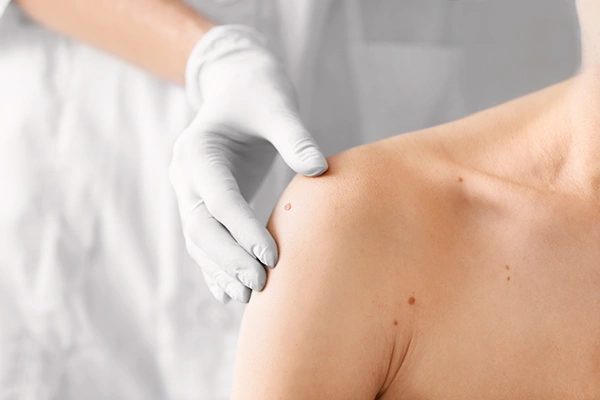Mole Removal
Dermatology Associates of Central NJ
Dermatologists & Mohs Surgery located in Old Bridge, Toms River, Union & Freehold, NJ
If you’ve found a new mole on your skin and are unsure if it’s dangerous, speak with the staff at Dermatology Associates of Central NJ. The practice has locations in Old Bridge, Union, Toms River, and Freehold, New Jersey, so you’ll find a convenient location with caring providers ready to help diagnose and erase moles. Book online or call for available appointments without delay.
Mole Removal Q & A
What is a mole?
Moles are commonly found dark-brown skin growths. Moles usually appear in childhood and teenage years and vary in shape and size. Moles can be flat or raised, smooth or wrinkled, and may have hair growing in them. They can develop anywhere on your body, including your scalp and between your fingers and toes.
How are moles caused?
Melanin provides your skin color. When clusters of skin cells group together, the melanin responds with darker colors in the form of a mole or skin patches. Some moles are affected adversely by the sun.
Are all moles cancerous?
Most moles are not dangerous or cancerous. Protecting your skin from harmful ultraviolet radiation reduces your risk of moles becoming cancerous or of cancerous melanomas developing.
How do I know if a mole needs to be removed?
You should regularly check your body for new moles and determine if they meet the criteria of harmful moles. You can use the ABCDE guide for new or existing moles. The guide includes:
- A: Asymmetrical shape
- B: Border
- C: Color
- D: Diameter
- E: Evolving
Changes in your mole may indicate precancerous growth and may need to be erased. If your moles change in color, shape, or size, speak with the knowledgeable staff at Dermatology Associates of Central NJ.
How are moles removed?
Having your mole erased involves your doctor numbing the area and then cutting the mole off your skin. In some cases, your doctor uses Mohs surgery if the mole is precancerous or cancerous.
Mohs surgery ensures removal of all cancerous cells from your mole. Mohs surgery erases the majority of your mole and an extra layer beneath the mole. Your doctor examines the extra layer for cancerous cells and determines if another thin layer needs to be erased.
If you're concerned about a mole on your skin because the size, shape, or color has changed, speak with an expert at Dermatology Associates of Central NJ. Your moles can change as you age, but some changes are unhealthy. Call for your appointment at any of the three locations, or you can book your appointment online.
*Individual results may vary.

Dermatological Services
-
 Morpheus8 Microneedlingmore info
Morpheus8 Microneedlingmore info -
 Chemical Peel - VI Peelmore info
Chemical Peel - VI Peelmore info -
 Acnemore info
Acnemore info -
 Botoxmore info
Botoxmore info -
 Mohs Surgerymore info
Mohs Surgerymore info -
 Mole Removalmore info
Mole Removalmore info -
 CoolSculptingmore info
CoolSculptingmore info -
 Eczemamore info
Eczemamore info -
 Rashesmore info
Rashesmore info -
 Rosaceamore info
Rosaceamore info -
 Skin Cancermore info
Skin Cancermore info -
 Hair Lossmore info
Hair Lossmore info -
 Wartsmore info
Wartsmore info -
 Skin Infectionsmore info
Skin Infectionsmore info -
 Tattoo Removalmore info
Tattoo Removalmore info -
Superficial Radiotherapymore info
-
 Juvedermmore info
Juvedermmore info -
 HydraFacialmore info
HydraFacialmore info -
EvolveXmore info
-
 SKINPENmore info
SKINPENmore info -
 Dermaplaningmore info
Dermaplaningmore info



















